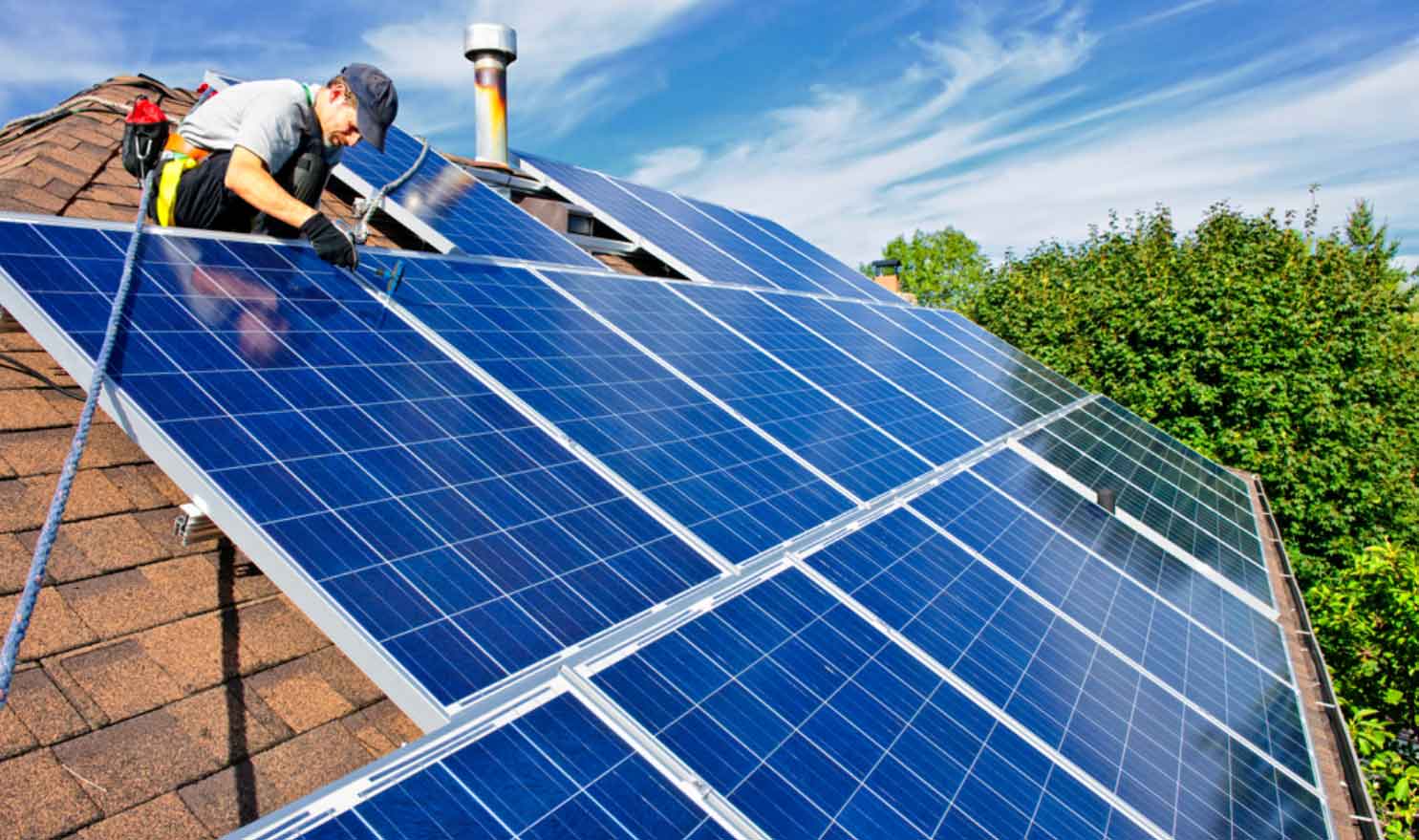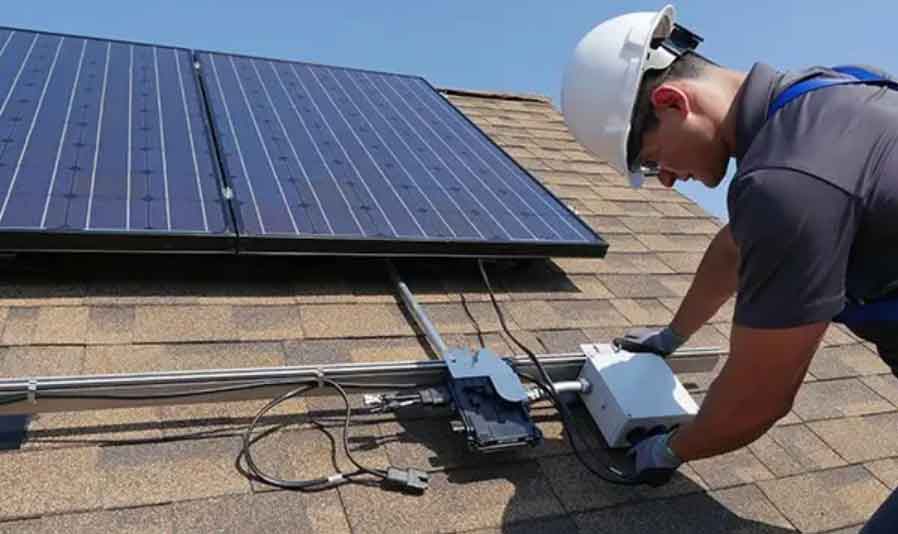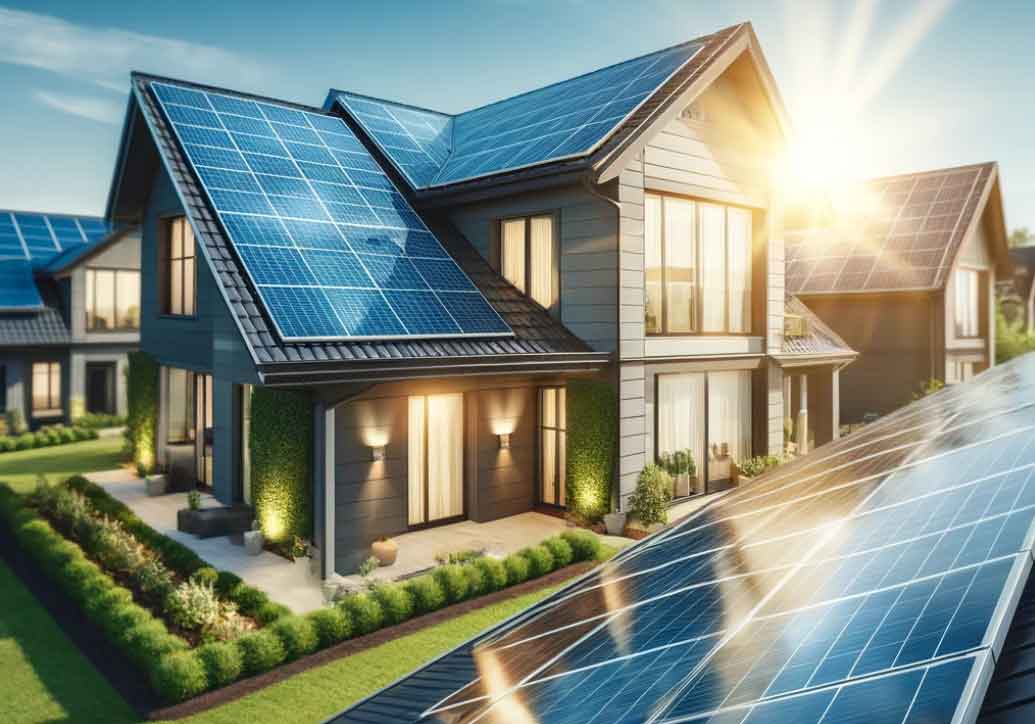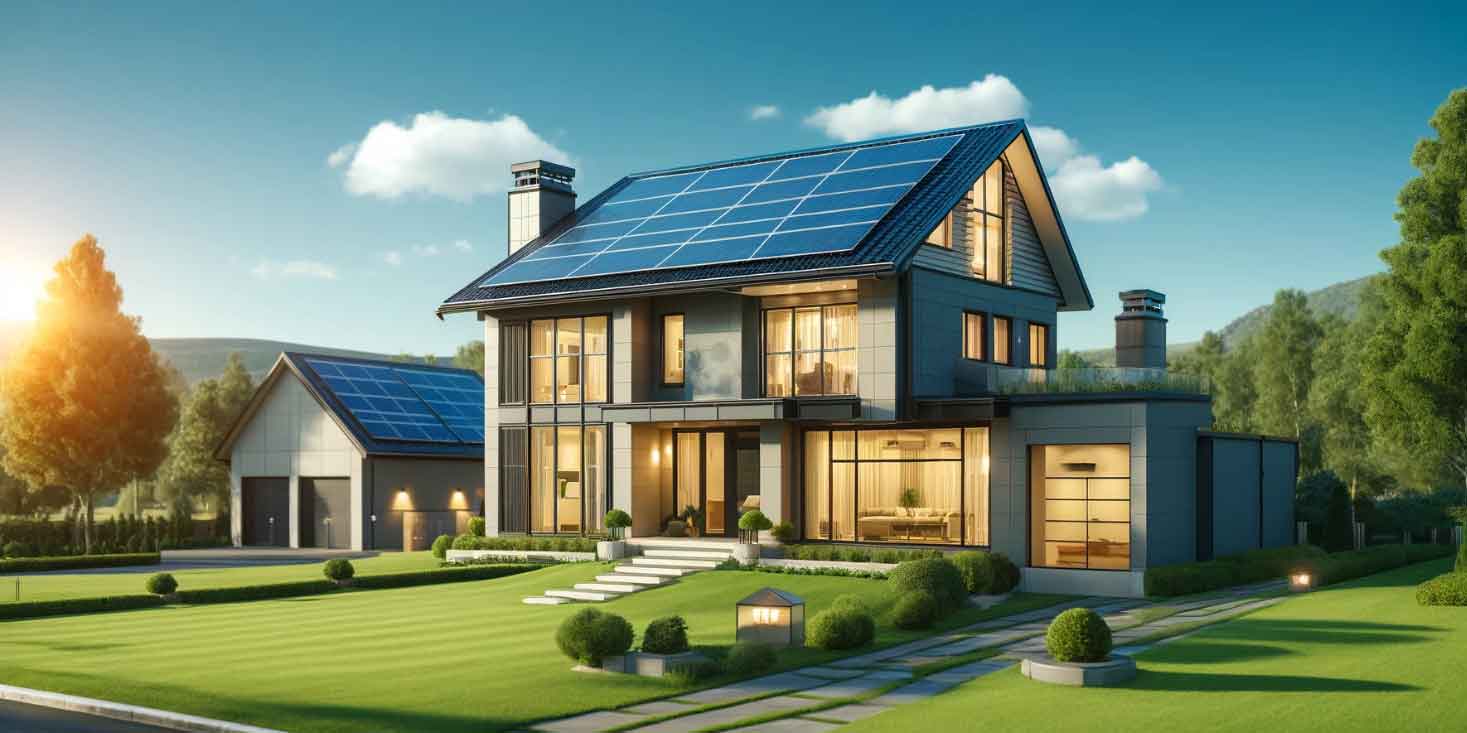Chapter 1: Utilizing Solar for Home Efficiency

Utilizing solar for home efficiency is a strategic approach to reducing energy costs, minimizing environmental impact, and enhancing the overall energy use in your home. Here’s how you can effectively integrate solar power into your home for maximum efficiency:
1. Solar Panel Installation
- Opt for High-Efficiency Panels: Choose solar panels with high efficiency to get the most energy production per square foot of roof space.
- Professional Assessment for Optimal Placement: Have a professional assess your home to determine the best placement for solar panels, considering factors like roof orientation, angle, and shading.
2. Integrating Solar for Home Energy Systems
- Smart Inverters: Use smart or micro inverters which can maximize energy production by optimizing the output of each individual panel.
- Battery Storage: Install a solar battery storage system to store excess energy generated during the day for use at night or during cloudy days.
3. Energy Efficiency Audits
- Conduct a Home Energy Audit: Identify areas where your home may be losing energy and implement changes to improve overall energy efficiency.
- Upgrade to Energy-Efficient Appliances: Consider replacing old, energy-intensive appliances with newer, energy-efficient models.
4. Smart Home Integration
- Automated Energy Management Systems: Use smart home technology to control and optimize energy use, such as smart thermostats, lighting, and appliances.
- Real-Time Energy Monitoring: Install a system that allows you to monitor your energy production and consumption in real-time, helping you to adjust usage habits for maximum efficiency.
5. Utilizing Solar for Heating and Cooling
- Solar Water Heaters: Install a solar water heating system, which can be an efficient way to use solar for home energy for your hot water needs.
- Solar-Powered Ventilation: Use solar-powered fans for attic or greenhouse ventilation to reduce cooling costs in the summer.
6. Solar-Powered Appliances and Tools
- Outdoor Lighting: Use solar-powered lights for outdoor spaces.
- Garden Tools: Utilize solar-powered tools and appliances for gardening and outdoor maintenance.
7. Green Building Design
- Building-Integrated Photovoltaics (BIPV): If building a new home or renovating, consider BIPV, where solar elements are integrated directly into the building material.
8. Community Solar Projects
- Participate in Community Solar: If installing solar panels isn’t feasible, consider joining a community solar for home program to benefit from solar energy.
9. Educate and Update
- Stay Informed: Keep up-to-date with the latest advancements in solar for home technology and energy efficiency.
- Regular Maintenance: Ensure your solar panels and energy systems are regularly maintained for optimal performance.
Challenges
- Initial Investment: The upfront cost of installing solar panels and related systems can be significant.
- Site Limitations: Not all homes are ideally situated for solar panel installation due to factors like shading, roof condition, or property orientation.
Conclusion
Utilizing solar for home efficiency is a multi-faceted approach that involves not just the installation of solar panels, but also integrating them effectively into your overall home energy system. By combining solar for home with energy efficiency measures and smart technology, you can significantly reduce your environmental footprint and energy costs, while enhancing the comfort and value of your home.
Chapter 2: The Latest in Solar for Home Technology

The solar for home technology landscape is constantly evolving, with new advancements enhancing the efficiency, accessibility, and functionality of solar for home systems for home use. Staying abreast of the latest in this field is key for homeowners considering solar energy. Here’s a look at some of the most recent and significant developments:
1. High-Efficiency Solar Panels
- Perovskite Solar Cells: These are a new class of solar for home cells with the potential to offer higher efficiency rates at lower costs than traditional silicon cells.
- Bifacial Solar Panels: Capable of capturing sunlight from both sides, these panels can generate more electricity than traditional single-sided panels.
2. Enhanced Battery Storage
- Lithium-Ion Batteries: The efficiency and capacity of lithium-ion solar for home batteries continue to improve, offering better energy storage solutions.
- Solid-State Batteries: An emerging technology, solid-state batteries promise higher energy density, faster charging, and longer lifespans.
3. Building-Integrated Photovoltaics (BIPV)
- Solar Roof Tiles and Shingles: These seamlessly integrate solar for home technology into building materials, offering an aesthetic and efficient alternative to traditional panels.
- Transparent Solar Panels: New developments in transparent photovoltaics allow windows to generate solar for home power while still serving their traditional function.
4. Smart Solar Systems
- Smart Inverters: These devices can optimize power output, manage grid connections, and even provide grid services.
- AI and IoT Integration: Artificial intelligence (AI) and the Internet of Things (IoT) are being used to manage energy production and distribution more efficiently, tailoring it to usage patterns.
5. Solar-Powered Home Appliances
- Solar Air Conditioning: Utilizing solar for home power for cooling reduces reliance on the grid during peak summer months.
- Solar Water Heaters: Efficiently using solar for home energy for heating water further reduces electricity or gas costs.
6. Electric Vehicle (EV) Solar Integration
- Solar EV Chargers: solar for home panels can be integrated with EV charging stations, providing a green energy source for electric vehicles.
- Solar-Powered EVs: Some electric vehicles are now coming with built-in solar for home cells for auxiliary power.
7. Peer-to-Peer (P2P) Energy Trading
- Blockchain Technology: This allows homeowners to sell excess solar for home energy to neighbors or the local grid through secure, decentralized platforms.
8. Portable and Flexible Solar Options
- Portable Solar Panels: For those who cannot install traditional panels, portable solar for home options offer flexibility and ease of use.
- Flexible Solar Films: Thin, flexible solar for home panels can be applied to a variety of surfaces, expanding the potential for solar for home energy harvesting.
Challenges and Considerations
- Cost: While prices are dropping, the initial investment for the latest solar for home technology can be significant.
- Regulatory Environment: As solar for home technology advances, regulations and grid infrastructure may need to catch up.
- Technological Maturity: Some emerging technologies, like perovskite cells and solid-state batteries, are not yet widely available commercially.
Conclusion
The latest advancements in solar for home technology for homes are making solar energy more efficient, versatile, and integrated with modern living. From high-efficiency panels to smart solar for home systems and energy storage, these innovations are paving the way for more sustainable, self-sufficient homes while addressing environmental concerns. As the technology continues to evolve and become more cost-effective, solar for home energy is set to become an increasingly vital part of residential energy solutions.
Chapter 3: Advancements in Residential Solar for Home Systems

Residential solar for home technology has made significant strides in recent years, evolving to become more efficient, cost-effective, and integrated with modern home energy systems. These advancements not only enhance the appeal of solar for home energy as a sustainable option for homeowners but also contribute to the overall energy efficiency and utility of the technology. Here’s a look at some key developments in residential solar for home systems:
1. High-Efficiency Solar Panels
- Perovskite Solar Cells: These are emerging as a promising alternative to traditional silicon cells, potentially offering higher efficiency rates and lower manufacturing costs.
- Bifacial Solar Panels: Designed to capture sunlight from both sides, bifacial panels increase energy generation potential compared to traditional single-sided panels.
2. Solar Storage Improvements
- Advanced Battery Technology: The advent of lithium-ion batteries and potential future developments like solid-state batteries provide more efficient ways to store excess solar for home energy.
- Integrated Systems: Some systems now combine solar for home panels and battery storage in a seamless setup, enhancing efficiency and ease of use.
3. Smart Solar Systems
- Smart Inverters and Micro Inverters: These technologies maximize energy production by optimizing output for solar for home panel.
- AI and Machine Learning: By incorporating AI, solar for home systems can intelligently manage energy production and distribution based on real-time data and usage patterns.
4. Building-Integrated Photovoltaics (BIPV)
- Aesthetic Integration: Solar cells can now be integrated into building materials like roof tiles or windows, making them less obtrusive and more architecturally appealing.
- Versatility in Applications: BIPV offers diverse applications, ranging from solar for home shingles to solar glass, providing more options for homeowners.
5. Enhanced Connectivity and Monitoring
- Internet of Things (IoT): Integration with IoT devices allows for real-time monitoring and management of energy use, enhancing the overall efficiency of the home’s energy system.
- Remote Management: Homeowners can monitor and adjust their solar for home system’s performance from smartphones or computers.
6. Solar-Electric Vehicle (EV) Synergy
- EV Charging Stations: The integration of solar for home panels with EV charging stations enables the use of renewable energy to power electric vehicles.
- Solar-Powered EVs: Some electric vehicles are now incorporating solar for home panels to extend their range or power auxiliary systems.
7. Flexible and Portable Solar Options
- Portable Solar Panels: Offering flexibility for those who cannot install traditional panels, these can be used for a variety of purposes, from home use to outdoor recreation.
- Flexible Solar Films: These thin, flexible panels can be applied to various surfaces, expanding the possibilities for solar for home energy collection.
Challenges
- Cost and Accessibility: While costs are decreasing, the initial investment for advanced solar for home technologies can still be significant.
- Technology Maturity: Some of the newer technologies, like perovskite solar for home cells, are still in the development or early commercialization stages.
- Regulatory and Grid Integration: Integrating these advanced systems into existing grid infrastructure and navigating regulatory environments can pose challenges.
Conclusion
The advancements in residential solar for home technology reflect a growing emphasis on efficiency, integration, and user-friendliness. From high-efficiency solar for home panels to smart energy management and aesthetically pleasing BIPV options, these developments are making solar for home power more accessible and attractive to homeowners. As technology continues to evolve, we can expect even more innovative solutions that further enhance the viability and appeal of residential solar for home energy systems.
Chapter 4: Tips of Integrating Solar for Home Energy

Integrating solar for home energy into your home is a great way to harness renewable energy and reduce your environmental impact while also potentially saving on energy costs. Here are some tips to ensure a smooth integration of solar for home power into your home energy system:
1. Conduct an Energy Audit
- Assess Your Energy Needs: Understand your current energy consumption to determine the size and type of solar for home system you need.
- Identify Efficiency Upgrades: Implementing energy-saving measures before installing solar for home can reduce the size and cost of the system needed.
2. Understand Your Solar Potential
- Evaluate Sunlight Exposure: Assess the amount of sunlight your property receives, considering factors like location, roof angle, and possible shading.
- Use Solar Mapping Tools: Many regions have online tools to help you estimate solar for home energy potential.
3. Choose the Right Type of Solar System
- Grid-Tied Systems: These systems are connected to the public electricity grid and can offset your electricity use; they’re most common in urban and suburban areas.
- Off-Grid Systems: If you’re in a remote location, an off-grid system with battery storage might be necessary.
- Hybrid Systems: Combining grid connection with battery storage offers a balance of reliability and independence.
4. Research and Select Appropriate Equipment
- Solar Panels: Research the types (monocrystalline, polycrystalline, thin-film) and their efficiencies.
- Inverters: Choose between string inverters, microinverters, or hybrid inverters based on your system’s needs.
- Battery Storage: If you plan to store excess energy, consider the capacity and lifespan of different battery options.
5. Find a Reputable Installer
- Certification and Experience: Look for certified professionals with experience in installing the type of system you’re considering.
- Get Multiple Quotes: Compare quotes from different installers to ensure you’re getting the best deal.
6. Understand Financing and Incentives
- Research Incentives: Look into federal, state, and local incentives, rebates, and tax credits that can reduce the cost of solar for home system.
- Explore Financing Options: Solar leases, power purchase agreements (PPAs), and solar for home loans can help manage the upfront costs of installation.
7. Plan for Installation and Maintenance
- Permitting Process: Work with your installer to navigate any necessary permits or regulations in your area.
- Maintenance Requirements: While solar for home systems require minimal maintenance, regular checks and cleaning can optimize their performance.
8. Optimize Your Home for Solar Use
- Energy Usage Patterns: Consider using major appliances during sunlight hours to maximize direct solar for home usage.
- Smart Home Integration: Smart energy systems can automate the efficient use of solar for home power in your home.
9. Consider Future Needs
- Scalability: Plan for potential expansions of your system as your energy needs change or as new technologies emerge.
Conclusion
Integrating solar for home into your home energy system is a forward-thinking decision that benefits both the environment and your wallet. By carefully assessing your needs, researching options, and working with experienced professionals, you can ensure that your transition to solar energy is successful and satisfying.
Chapter 5: The Impact of Solar for Home Sustainability

The impact of solar for home energy on home sustainability is profound and multi-faceted. By harnessing solar for home power, homeowners can significantly reduce their environmental footprint while contributing to broader efforts in renewable energy adoption. Here’s a detailed look at the impact of solar for home energy on home sustainability:
1. Reduction in Carbon Footprint
- Clean Energy: Solar for home power is a renewable, clean energy source that doesn’t emit greenhouse gases during operation, unlike fossil fuels.
- Reduced Reliance on Non-Renewable Energy: By using solar for home panels, homes lessen their dependence on fossil fuels, contributing to a decrease in overall carbon emissions.
2. Energy Efficiency
- Direct Use of Produced Energy: Solar for home panels generate electricity that can be used directly, reducing the loss that occurs in energy transmission over long distances from power plants.
- Enhanced Efficiency with Modern Technology: Advancements in solar for home technology, like high-efficiency panels and smart solar for home systems, ensure more effective use of captured solar energy.
3. Long-Term Sustainability
- Durable Systems: Solar for home panels typically have long lifespans, often around 25-30 years, making them a sustainable investment for long-term energy production.
- Sustainable Energy Source: Solar for home energy is abundant and inexhaustible in human terms, providing a sustainable source of energy without depleting natural resources.
4. Financial Savings and Energy Independence
- Reduced Energy Bills: Solar for home panels can significantly lower electricity bills, and in some cases, completely offset them.
- Protection from Energy Price Fluctuations: Generating your own power shields you from the volatility of energy prices in the traditional market.
5. Enhancing Local Environments
- Reduced Air and Water Pollution: Solar for home energy production doesn’t release harmful pollutants into the air or water, contributing to cleaner local environments.
- Minimal Water Usage: Unlike many conventional power generation methods, solar for home energy production requires very little water, conserving this vital resource.
6. Contribution to Grid Stability
- Energy Contribution During Peak Demand: Homes with solar for home systems can contribute excess energy to the grid, especially during peak demand times, helping to stabilize the grid.
- Reduced Infrastructure Strain: Widespread home solar for home adoption can lessen the burden on existing power grids and reduce the need for additional power plants.
7. Community and Societal Benefits
- Promoting Renewable Energy Growth: Adoption of solar for home energy by homeowners contributes to the growth and development of the renewable energy sector.
- Setting an Example: Homeowners using solar for home power often inspire others in their community to explore renewable energy options.
Challenges and Considerations
- Initial Setup Costs: The initial cost of solar for home panel installation can be high, although this is offset by long-term savings and various incentive programs.
- Variable Efficiency: The efficiency of solar for home panels can vary based on location, weather conditions, and installation specifics.
- Need for Space: Effective solar for home panel installation requires sufficient space, typically on rooftops, which may not be feasible for all homes.
Conclusion
Integrating solar for home power into residential settings plays a crucial role in driving the sustainability agenda forward. The environmental benefits, coupled with long-term financial savings and energy independence, make solar for home energy a key component of sustainable living. As solar technology continues to advance, its role in achieving environmental sustainability and energy resilience is likely to grow even more prominent.
